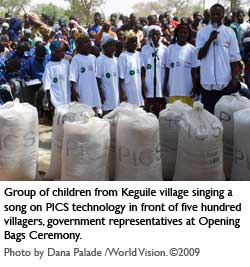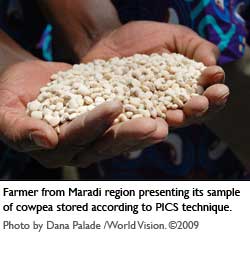Niger: The peaks of cowpea storage - Food security for millions
Story by Dana Palade
Five hundred farmers, government representatives participated in a groundbreaking "Opening Bags Ceremony” organized by World Vision Niger, and officiated by the Governor of Maradi region in Keguile village, some 600 km east from capital Niamey.
The sample bags contained one of the most important indigenous African grain - the cowpea - now stored in a cheap, simple and non-chemical way promoted by WV project PICS (Purdue Improved Cowpea Storage) in almost 6,000 villages.
“PICS project reaches about ten million people in Niger. It is a great example of collaboration and success, as several factors reinforce its importance for households’ food security,” says Dr. Hannibal Muhtar, World Vision’s Africa Livelihoods Security Team Leader.
The hermetic storage method uses a triple-layer plastic bag that prevents the air from coming in. As insects cannot survive without oxygen, this simple technique allows farmers to preserve their crops without the contamination of toxic pesticides, and free from insect damage, for longer.

“Now farmers can store cowpea harvests longer at home, so their families can enjoy healthy meals, rich in proteins, several times a week.”
Dr. Muhtar adds that, before PICS technology, villagers in Niger experienced up to ten months of hunger, now they will have no month of food shortages.
Niger is the second largest exporter of cowpea in the world. However, its impoverished rural population, living on less than US$ 2 per day, could rarely enjoy the full economic benefits of their cowpea harvest.
Cowpea is very vulnerable to insects, so two months after harvest up to 50 percent of the grain was totally destroyed. Farmers had to sell the cowpea at harvest time when prices are the lowest of the year, simply because it was better to sell the grain than have the insects eat them.
“Using PICS storage method, farmers can wait and sell whenever the market is good for them,” explains
Dr. Muhtar, “so there is a significant economic benefit.”
Indeed, it is anticipated that the project will increase income by an average of US$ 150 per household.
For Sa’a Saidou, a widowed mother of seven living in the nearby village of Sabon Machi, this is the second year she has stored cowpea using PICS method. She remembers that in the beginning farmers met the new technique with skepticism.
“People couldn’t imagine that something so simple would really work,” Sa’a says, “until I opened my first bag and all of the grain was intact.” Sa’a became one of the most outspoken advocates for the new storage technique.
“I talk to my friends about it, when we gather for tea, and I also encourage my sons to use it,” she adds.The technology was tested for about 20 years, and its promoters hope it will become the standard way to store cowpea.

Purdue University, USA, partnered with World Vision and the National Institute for Agricultural Research of Niger (INRAN) to implement the technique.
“PICS’ progress in Niger is impressive, and the response from farmers very positive,” says Dr. Jess Lowenberg-DeBoer, Associate Dean and professor of Agricultural Economics at Purdue University.
“We expect a long-term impact, because cowpea will become a cash crop,” adds Dr. Lowenberg-DeBoer.
“More families will have higher incomes, and that means better schooling for children, better health care, and meeting all the basic needs.”
Author’s Notes:
PICS is a regional, five-year project that helps poor households and local traders in ten West African countries to increase food security and income through improved cowpea storage methods. The project is financed by the Bill and Melinda Gates Foundation.